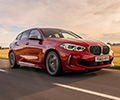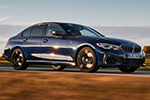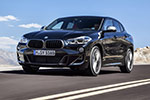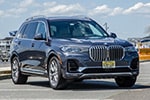The automotive world is getting increasingly electric, and the BMW brand is not immune. In fact, the brand is really one of the forerunners of EV and hybrid adoption – and it shows in the overall competency of their current lineup. While the US market misses out on a handful of hybrid offerings for the time being that the rest of the world does see, there’s still a lot to love. Here’s a recap of every MHEV (mild-hybrid) and PHEV (plug-in hybrid) BMW you can buy in the US.
BMW PHEVs For Sale in the US

Plug-in hybrid electric vehicles, or PHEVs, are gaining in popularity. Surprising, then, that the BMW PHEV lineup has actually lost one member, year-over-year. The 330e, formerly available stateside, is currently nowhere to be found. That’s not to say the pickings are slim, though – there are a huge range of PHEVs to choose from. Powerful six- and eight-cylinder engines team up with motors and batteries to offer pretty competitive range. And, in some offerings, of course, commendable power figures.
BMW Sedan PHEVs in the US
While the 330e is gone, shoppers still get plug-in variants of the 5 Series and 7 Series. The 550e xDrive offers up to 33 miles of all-electric range, and touts 483 horsepower. The 750e xDrive relies on the same powertrain, and BMW says it’ll go up to 36 miles on all-electric power. Of course, range will depend on how you drive and the wheel size you opt for.
The first-ever BMW M PHEV is live, too – the M5 and M5 Touring. 717 horsepower allows sedan models to fly from zero to 60 mph in a mere 3.5 seconds. You’re stuck with 25 miles of range, according to BMW, but if you’re anything like us, you probably won’t even make it that far due to an accute case of buried accelerator syndrome.
BMW SUV PHEVs in the US
The only plug-in BMW SUV many shoppers will be able to consider is, luckily, a fantastic overall package: the X5 xDrive50e. It too relies on the B58 + motor/battery combination. The same 483 horsepower is on tap, and the X5 can roam up to 40 miles on nothing more than electric power. That’s pretty impressive.
Equally impressive but for very different reasons is the other PHEV BMW you can buy in the states: the BMW XM. Whether you opt for the 644-horsepower base car or the 738-horsepower XM Label, you’ll enjoy a sonorous and mighty V8 engine teamed up with an electric motor, battery, and xDrive all-wheel drive. Acceleration from zero to 60 mph takes just 3.6 seconds in the latter. You’ll have to make do with around 30 miles of range, though. Not a bad trade-off; just don’t look at the price tag. Or the front of the vehicle. Or back.
BMW Mild Hybrids (MHEVs) For Sale in the US
While the PHEV lineup has become arguably less crowded, the mild hybrid lineup is vast as it as ever been over at BMW. What is a mild hybrid, or MHEV? The simplest way to explain them – if you aren’t interested in reaching our eBoost and mild hybrids explained article – is that they use a motor and battery setup alongside a combustion engine. However, the vehicle is not ever powered exclusively by this system – even for short distances. The vehicle can use the motor and battery setup for a variety of other purposes, though. The electrical system can supplement the engine for additional power, or increased efficiency. Similarly, the system engages during startup, resulting in a quicker start, less NVH, and fewer emissions. After the B58 began relying on mild hybrid power – sometime in mid-2020 – almost every BMW derivative has become electrified in some way.
BMW MHEV Sedans, Coupes, Convertibles
The B58-powered cars have been mild hybrids for a while. That includes the M Performance lineup of vehicles – so M240i, M340i, Z4 M40i, and M440i. The 540i xDrive and 740i sedans are also B58 powered, making both mild hybrids.
With the advent of the B48B20O2 – the variant of BMW’s modern four-cylinder engine that relies on the new mild hybrid technology – there are a few more additions to the MHEV lineup. The newest models of the 330i and 430i get it, as does the new 5 Series (530i).
BMW MHEV SUVs
If you want a mild hybrid BMW SUV, your choices are actually somewhat more limited. The X1 and X2 do not rely on a mild hybrid setup, but the new X3 30 xDrive does. Six-cylinder X4 M40i and X3 M50 models rely on the B58, which of course, means a mild hybrid component. All variants of the 2025 BMW X5 and X6 – including the full-blown M variants and M60i variants – come with mild hybrid technology. The same goes for the X7 – even the ALPINA XB7.
There’s no doubt about it: you have plenty of options when shopping for a hybrid BMW vehicle. While the increased overall complexity of the systems may deter some shoppers, some seriously impressive power and efficiency gains make them worthy of a look – even if it’s just for a particularly spirited test drive.










































































